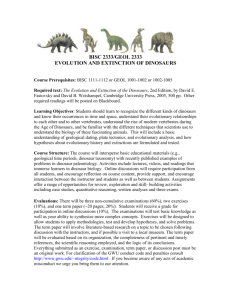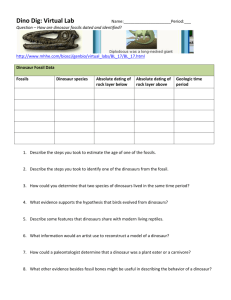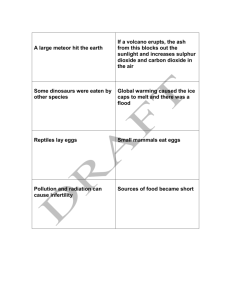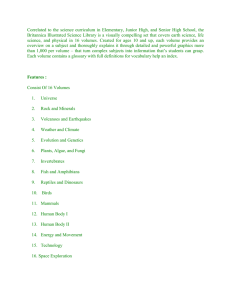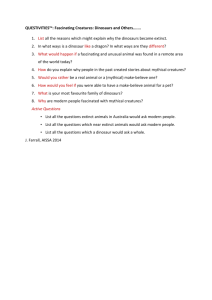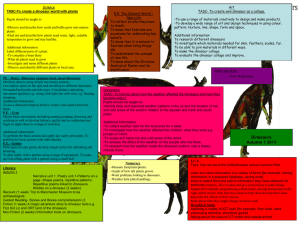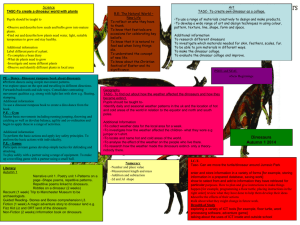Thermoregulation in Dinosaurs
advertisement
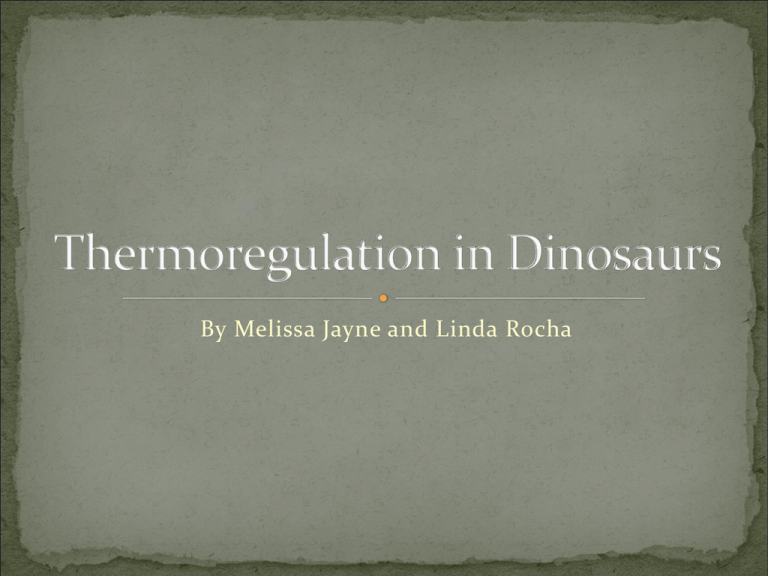
By Melissa Jayne and Linda Rocha Internal heat production through metabolism Examples and Birds Mammals Obtaining heat from the external environment. Examples: Amphibians, insects, and reptiles. “Homeothermy is the maintenance of a constant temperature independent of external temperatures.” According to this hypothesis, dinosaurs were cold- blooded and had a low metabolism. Larger dinosaurs would have had a lower surface area to volume ratio and were therefore able to maintain a relatively constant body temperature. As body size increases so should body temperature. Bakker (1986) Only applies to large dinosaurs Hypothesis is unable to explain the success of dinosaurs over mammals. Smaller dinosaurs had a high metabolism and therefore it is unlikely that larger dinosaurs would have evolved to have a low metabolism. Inertial homeothermy does not work in today’s ecosystems. J.F. Gillooly, A.P. Allen, and E.L. Charnov (2006) Presented a model that predicted the body temperatures of dinosaurs using “ontogenetic growth trajectories obtained from fossil bones.” Data on the ontogenetic growth trajectories of eight different dinosaur species were collected. The masses of these dinosaurs ranged from 12kg (P. mongoliensis) to 12,979 Kg (Ap. excelsus). Tyrannosaurus Rex is only 1/12 the size of Apatosaurus Excelsus. P. Mongoliensis T. Rex This equation is used in a model that predicts the effects of body size and temperature on growth rate. G = g0M3/4e0.1Tb G = Growth rate (Kg day-1) g0 = Normalization Constant (~ 2 x 10-4 Kg1/4 day-1 ) M = Mass at maximum growth (Kg) e0.1Tb = Temperature Term (takes into account the biochemical reactions involved in growth and represents the average activation energy) Tb = Body Temperature (˚C) The terms in the previous equation can be rearranged in order to predict the body temperatures of specific dinosaur species. Tb = 10ln(GM-3/4/g0) P. mongoliensis M = 12 Kg G = ~ 1.57 x 10 -2 Kg day-1 g0 = 2 x 10-4 Kg1/4 day-1 By using the data provided above we can solve for T b Tb = 10 ln[(.0157 Kg day-1 x 12 -3/4kg)/ (2 x 10-4 Kg1/4 day-1)] T b = ~ 25°C According to Parrish, crocodiles are the last living non-avian Archosaurs. Crocodiles are the largest living reptiles and have a vast ontogenetic size range. “A plot of the relationship between Average Body Temperature (°C) and the Logarithm of Body Mass for Dinosaurs and Extant Crocodiles.” “ A plot of observed versus the predicted increase in average body temperature (°C) with body mass for crocodiles.” Create and test a model that determines the metabolic rate of various dinosaurs in order to support or oppose the inertial homeothermy hypothesis. Archosaurs: A group of reptiles represented by modern birds and crocodilians. Ontogeny: the development of an organism from the fertilized egg to its mature form. Bakker, R.T. The Dinosaur Heresies: New Theories Unlocking the Mystery of the Dinosaurs and Their Extinction. New York: Kensington Publishing Corp. 1986. Gillooly, J.F., A.P. Allen and E.L. Charnov. 2006. Dinosaur Fossils Predict Body Temperatures. PLos Biology. 4:1467-1469. Gross, L. 2006. Math and Fossils Resolve a Debate on Dinosaur Metabolism. PLoS Biology. 4:1296. Parrish, J.M. 1997. Evolution of the Archosaurs. Farlow and Brett Surman 191-203 Ruxton, G.D. 2001. Heat loss from giant extinct reptiles. The Royal Society. 268:1921-1924. Seebacher, F. 2003. Dinosaur body temperatures: the occurrence of endothermy and ectothermy. Paleobiology. 29(1):105-122. Smith, R.L. and T.M. Smith. Elements of Ecology. 5th ed. San Francisco: Benjamin Cummings, 2003. Terblanche, J.S. 2007. Big Dinosaurs: Hot or Not? The Journal of Experimental Biology. 210

